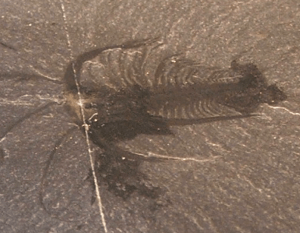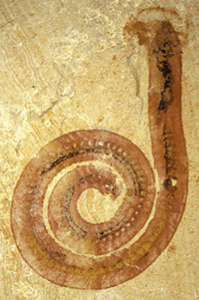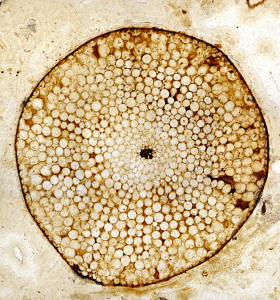Guest Author: Dr Rachel Kruft Welton
Current Palaeobiology MSc Student, University of Bristol
Lagerstätten are fossil deposits containing exceptionally preserved remains of creatures from the past. Often soft parts have been preserved and snap-shots of organisms in life-like positions have been captured. The creation of such a fossil deposit is an enormously rare event, and as such, Lagerstätten have been enthusiastically studied.
1 – The Burgess Shale
In 1909 Charles Doolittle Walcott and his family were crossing part of the Canadian Rocky Mountains in British Columbia, known as the Burgess Pass, when his wife Helena’s horse tripped on a rock, nearly unseating her. Instead of leaping to her aid, the story goes, Walcott leapt to the rock, which contained the most exquisitely preserved fossil of a lace crab, Marrella splendens. What Walcott had stumbled on, literally, was a goldmine of exceptionally preserved fossils from the Middle Cambrian, about 505 million years old. Over the following years Walcott collected over 60,000 fossils from what is now known as the Burgess Shale.
The Burgess Shale has a special place in my heart. Stephen Jay Gould’s book “Wonderful Life” had just come out when I was writing my undergraduate dissertation, and it had an enormous influence on me, catapulting my imagination into the offshore marine ecosystem that these fantastic creatures inhabited. Five-eyed Opabinia rubbed proboscis with the predatory Anomalocaris, whist the early Chordate Pikaia slunk through the muds with the spiny Hallucigenia. Just under half the species were arthropods, and a quarter of the arthropods were trilobites. A fifth of the Shale is made up of sponges, and there are members of many other recognisable phyla, such as molluscs, priapulid worms and echinoderms. Stephen Jay Gould argued that many of the fossils fell into unrecognised phyla, although more recent analyses has managed to place many of the unusual specimens into groups that were previously known. As an undergraduate, I felt as if I had stepped into a completely alien world.

The mudstones of the Burgess Shale contain fossils that have been tumbled and jumbled around. The preservation process shows that there was significant churning prior to final burial. It seems likely that there was an underwater mudslide or similar, which carried the community to an anoxia or very hypoxic environment, and buried the organisms rapidly, preventing decay. The clays present in the mud penetrated and mineralized the bodies of the creatures, even preserving impressions of the soft parts. The incredible detail allowed by this rare method of preservation, means that phylogenetic links at between otherwise mysterious creatures can be discerned.
2 – Chengjiang
A slightly older Lagerstätte was discovered in southern China, in Yunnan Province in 1984 by Hou Xian-guang. This collection of over 200 species dates to 525Ma, which is the mid to low Cambrian. The fossils are preserved in a yellowish mudstone, which is sometimes minerally altered to stain the fossils dark or to add a layer of pyritization.

The Chengjiang fossils consist of shallow marine fauna, which lived in a continental slope basin, possibly close to an estuary. What is truly awesome about the Chengjiang Lagerstätte is that it has not been tumbled about by a land-slide. Each fossil is preserved exactly as it was in life. There are even brachiopods still anchored to the sediment on the sea-bed by a delicate pedicle, which can be seen. A violent end would have uprooted such a structure and flung the shells into disarray. Instead, we see them all lined up in the way they would have been in life. Conceivably during a storm or heavy flooding, the sediment from the estuary was washed out over the area, burying everything as it grew, slithered and crawled.
Although Chengjiang is 20 million years older than the Burgess Shale, and comes from a more coastal region, it appears to have roughly the same proportions of phyla in it. Again, just under half the species are arthropods, although far fewer trilobites, surprisingly, and a similar percentage of sponges. The worm community is slightly different. Where the Burgess Shale specialises in priapulids, Chengjiang has nematodes, with their smooth bodies and sinuous shapes.
3 – Rhynie Chert
About an hour’s drive north-west of Aberdeen, where my son is at university, is an early Devonian Old Red Sandstone deposit called Rhynie Chert and its neighbour Windyfield Chert. Rhynie Chert was discovered by William Mackie in 1912, just before the First World War. The chert is around 400Ma, as determined by palynology (the study of pollen and spores) and radiometric dating, and contains the animals, plants and fungi preserved from plant litter surrounding a hot-spring system.
The hot-spring caused silicification of the organisms in the community, and this led to impeccably preserved three dimensional silicified plants. The detail is so minute, that individual cells can be seen. The fossil bed contains the oldest known land plants, and the detail with which they have been preserved shows not only they anatomy, but also allows every stage of their lifecycle to be pieced together. It is interesting to note, that plants did not have roots at this point in their evolution. The plants at Rhynie Chert had rhizoids with small hairy projections digging into the sediment.

Although famous for its fossilised plants, the site has also given us beautifully preserved invertebrates. The oldest insect, a springtail, is preserved so precisely, that the hairs on its cuticle can be seen, whereas a trigonotarbid arachnid has clear book lungs, showing that it must have been fully terrestrial.
The quality of each individual fossil very much depends on how much decay occurred before preservation, however, even the heavily decayed organisms allow an opportunity to study the fungi growing upon them. The oldest lichen ever discovered comes from this assemblage.
The three Lagerstätten described here are not the only fossil beds which have been found preserving soft tissues, but they do belong to a rare category, created by unusual fossilisation events. Lagerstätten give us an unequalled window into the past, that bones and shells alone cannot, and as such, palaeontologists rightly get enormously excited about the information they reveal.
References
Briggs, D & Crowther, P (2007) Palaeobiology II. Blackwell Publishing
Benton, M & Harper, D (2009) Palaeobiology and the Fossil Record. Wiley-Blackwell
Gould, SJ (1989) Wonderful Life: The Burgess Shale and the Nature of History. W. W. Norton & Company
Edited by Rhys Charles

